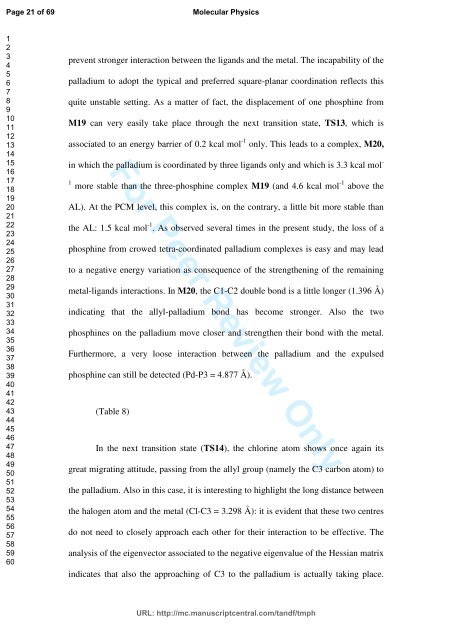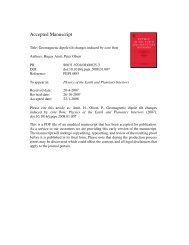For Peer Review Only - TARA
For Peer Review Only - TARA
For Peer Review Only - TARA
You also want an ePaper? Increase the reach of your titles
YUMPU automatically turns print PDFs into web optimized ePapers that Google loves.
Page 21 of 69<br />
Molecular Physics<br />
1<br />
2<br />
3<br />
4<br />
5<br />
6<br />
7<br />
8<br />
9<br />
10<br />
11<br />
12<br />
13<br />
14<br />
15<br />
16<br />
17<br />
18<br />
19<br />
20<br />
21<br />
22<br />
23<br />
24<br />
25<br />
26<br />
27<br />
28<br />
29<br />
30<br />
31<br />
32<br />
33<br />
34<br />
35<br />
36<br />
37<br />
38<br />
39<br />
40<br />
41<br />
42<br />
43<br />
44<br />
45<br />
46<br />
47<br />
48<br />
49<br />
50<br />
51<br />
52<br />
53<br />
54<br />
55<br />
56<br />
57<br />
58<br />
59<br />
60<br />
prevent stronger interaction between the ligands and the metal. The incapability of the<br />
palladium to adopt the typical and preferred square-planar coordination reflects this<br />
quite unstable setting. As a matter of fact, the displacement of one phosphine from<br />
M19 can very easily take place through the next transition state, TS13, which is<br />
associated to an energy barrier of 0.2 kcal mol -1 only. This leads to a complex, M20,<br />
<strong>For</strong> <strong>Peer</strong> <strong>Review</strong> <strong>Only</strong><br />
in which the palladium is coordinated by three ligands only and which is 3.3 kcal mol -<br />
1 more stable than the three-phosphine complex M19 (and 4.6 kcal mol -1 above the<br />
AL). At the PCM level, this complex is, on the contrary, a little bit more stable than<br />
the AL: 1.5 kcal mol -1 . As observed several times in the present study, the loss of a<br />
phosphine from crowed tetra-coordinated palladium complexes is easy and may lead<br />
to a negative energy variation as consequence of the strengthening of the remaining<br />
metal-ligands interactions. In M20, the C1-C2 double bond is a little longer (1.396 Å)<br />
indicating that the allyl-palladium bond has become stronger. Also the two<br />
phosphines on the palladium move closer and strengthen their bond with the metal.<br />
Furthermore, a very loose interaction between the palladium and the expulsed<br />
phosphine can still be detected (Pd-P3 = 4.877 Å).<br />
(Table 8)<br />
In the next transition state (TS14), the chlorine atom shows once again its<br />
great migrating attitude, passing from the allyl group (namely the C3 carbon atom) to<br />
the palladium. Also in this case, it is interesting to highlight the long distance between<br />
the halogen atom and the metal (Cl-C3 = 3.298 Å): it is evident that these two centres<br />
do not need to closely approach each other for their interaction to be effective. The<br />
analysis of the eigenvector associated to the negative eigenvalue of the Hessian matrix<br />
indicates that also the approaching of C3 to the palladium is actually taking place.<br />
URL: http://mc.manuscriptcentral.com/tandf/tmph
















